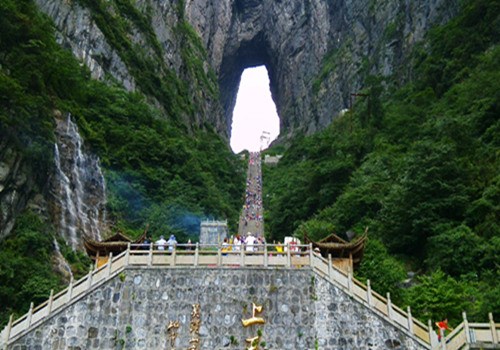
The Historical and Cultural Significance of Tianmen Mountain
Tianmen Mountain, towering over the landscape of Zhangjiajie, is not merely a geographical marvel but also a site steeped in history and culture. As the earliest recorded mountain in the region, its story interweaves with the rise and fall of dynasties, the evolution of religious beliefs, and the enduring human fascination with the heavens.
From Songliang Mountain to Tianmen: A Name Bestowed by Destiny
In the annals of history, Tianmen Mountain first appears under the name "Songliang Mountain" during the Han Dynasty (206 BC - 220 AD). This period, marked by the unification of China and the flourishing of Confucianism, saw the mountain revered for its imposing presence and natural splendor.
However, it was in the year 263 AD, during the tumultuous Three Kingdoms period, that Songliang Mountain underwent a transformative event that would forever alter its destiny. A colossal rockfall cleaved the mountain's face, leaving behind a gaping chasm that resembled a giant portal. Sun Xiu, the Emperor of Eastern Wu, interpreted this as an auspicious omen, a celestial gateway opening upon the earth. Thus, he bestowed upon the mountain a new name: Tianmen, meaning "Heaven's Gate."
A Sacred Abode for Taoist Seekers
Following the decline of the Han Dynasty and the rise of the Wei and Jin Dynasties (220 AD - 420 AD), Taoism, an indigenous Chinese philosophy emphasizing harmony with nature and the pursuit of immortality, gained widespread popularity. Tianmen Mountain, with its newly acquired celestial connotations, became an irresistible magnet for Taoist practitioners and devotees.
Seeking solace and enlightenment amidst the mountain's ethereal beauty, Taoists established a presence on its summit. This marked the genesis of Tianmenshan Temple, a testament to the mountain's spiritual significance. The temple flourished, expanding its grandeur to encompass:
| Feature | Description |
|---|---|
| Structure | Three main halls, interconnected and arranged along a central axis, signifying a hierarchical progression towards sacred space. |
| Chambers | Six smaller chambers flanking the main halls, likely used for meditation, scripture study, or housing resident monks. |
| Construction | Durable brick walls and heavy tiled roofs, reflecting the architectural style of the time and the temple's prosperity. The phrase "brick walls, iron tiles, pots as large as ponds" speaks to the temple's impressive scale and resources. |
The temple's scale and elaborate design serve as enduring testament to the profound influence of Taoism and Tianmen Mountain's role as a sacred site for those seeking communion with the divine.
Tianmen Mountain Today: A Fusion of History, Culture, and Natural Splendor
Today, Tianmen Mountain stands as a harmonious blend of its storied past and a vibrant present. The mountain attracts visitors from across the globe, drawn by its breathtaking scenery, cultural treasures, and the lingering mystique of its celestial gateway. The legend of its naming, the legacy of Taoist practices, and the architectural marvel of Tianmenshan Temple continue to captivate and inspire, ensuring that the mountain's historical and cultural significance remains as enduring as the rock formations that adorn its slopes.
Q&A
Q: What is the significance of the name "Tianmen Mountain"?
A: The name "Tianmen," meaning "Heaven's Gate," was bestowed upon the mountain in 263 AD by Emperor Sun Xiu of Eastern Wu. He interpreted a massive rockfall, which created a large opening on the mountain's face, as an auspicious sign – a gateway to heaven.
Q: How did Tianmen Mountain become associated with Taoism?
A: During the Wei and Jin Dynasties, Taoism flourished in China. Tianmen Mountain, with its newfound association with the heavens, became a sacred site for Taoists who believed it to be a conduit to spiritual enlightenment and immortality.
Q: What is the most iconic structure on Tianmen Mountain and what does it represent?
A: Tianmenshan Temple, located on the mountain's summit, is the most iconic structure. Its construction, featuring three main halls, six chambers, sturdy brick walls, and heavy tiled roofs, embodies the architectural grandeur of its time and stands as a testament to the mountain's enduring spiritual significance for Taoist practitioners and devotees.
note: This return of all, without the author's permission, may not be reproduced